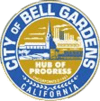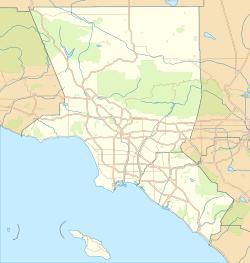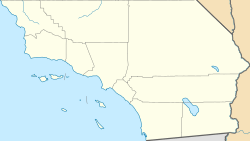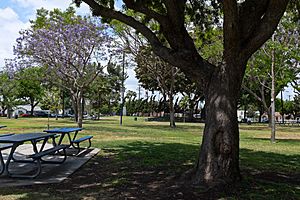Bell Gardens, California facts for kids
Quick facts for kids
Bell Gardens, California
|
|||
|---|---|---|---|
|
|||
| Motto(s):
Hub of Progress
|
|||
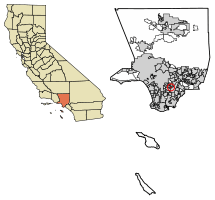
Location of Bell Gardens in Los Angeles County, California.
|
|||
| Country | United States | ||
| State | California | ||
| County | Los Angeles | ||
| Incorporated | August 1, 1961 | ||
| Government | |||
| • Type | Council-Manager government | ||
| • Body | Mayor Alejandra Cortez, Lisseth Flores (Mayor Pro Tem) Pedro Aceituno Marco Barcena |
||
| Area | |||
| • Total | 2.46 sq mi (6.38 km2) | ||
| • Land | 2.46 sq mi (6.37 km2) | ||
| • Water | 0.01 sq mi (0.01 km2) 0.18% | ||
| Elevation | 121 ft (37 m) | ||
| Population
(2020)
|
|||
| • Total | 39,501 | ||
| • Density | 16,063.85/sq mi (6,202.38/km2) | ||
| Time zone | UTC-8 (PST) | ||
| • Summer (DST) | UTC-7 (PDT) | ||
| ZIP Code |
90201, 90202
|
||
| Area code(s) | 213/323 | ||
| FIPS code | 06-04996 | ||
| GNIS feature IDs | 1660323, 2409817 | ||
Bell Gardens is a city in the U.S. state of California in the Los Angeles metropolitan area. Located in Los Angeles County, the city's population was 42,072 at the 2010 census, down from 44,054 at the 2000 census. Bell Gardens is part of the Gateway Cities Region, a largely urbanized region located in southeastern Los Angeles County.
Bell Gardens is notable for being one of only six Los Angeles County cities (out of 88 total) to permit casino gambling and for being home of the oldest building in Los Angeles County.
Bell Gardens is named after James George Bell, an American businessman. The “Gardens” in its name derives from the many Japanese who, early in Bell Gardens’ existence, established vegetable gardens and rice fields. The adjacent city of Bell is also named after James George Bell.
Contents
History
The city of Bell Gardens has a Native American history dating back thousands of years. In the late 18th century, when the area was associated with a large amount of land situated along the lower basin of the Rio Hondo area in Los Angeles County, Bell Gardens was once a bustling agricultural center for Californios during the Spanish Empire, 1509–1823, the Mexican government, 1823–1848, and the United States, after the Mexican-American war concluded in 1848.
Among those early Spanish settlers was one of California’s first families, the Lugos. While stationed at Mission San Antonio de Padua near Salinas, California, Francisco Lugo’s son Antonio Maria Lugo was born in 1783. In 1810 Antonio Lugo, a 35-year-old corporal in the Spanish army, was given the 29,514-acre (119.44 km2) Rancho San Antonio land grant. The land grant was a reward for his military service during the establishment of the Franciscan Missions in California while being the attendant of colonization for the area. Today the grant includes the cities of Bell Gardens, Bell, Maywood, Vernon, Huntington Park, Walnut Park, Cudahy, South Gate, Lynwood and Commerce.
Antonio Lugo built several adobe homes within the boundaries of the Rancho San Antonio grant, and raised cattle. One of the adobe houses, built in 1795, is the oldest house in Los Angeles County and is still standing at 7000 Gage Avenue. Lugo was given a term as Mayor of Los Angeles. According to Dr. Roy Whitehead in his book Lugo, "Don Antonio Maria Lugo…rode around Los Angeles and his Rancho San Antonio in great splendor. He never adopted American dress, culture or language and still spoke only Spanish. He rode magnificent horses, sitting in his $1,500 silver trimmed saddle erect and stately, with his sword strapped to the saddle beneath his left leg…People knew him far and wide, and even the Indians sometimes named their children after him, as he was one Spanish Don that they admired." Antonio María Lugo died at the age of 85 in 1860.
One of his nine children, Vicente Lugo, married and built a two-story adobe home in 1850, located at 6360 Gage Avenue. A daughter of Antonio Lugo married Stephen C. Foster, Mayor of Los Angeles in 1854, and lived in an adobe house just east of 6820 Foster Bridge Road, now a parking lot. A granddaughter of Antonio Lugo married Wallace Woodworth, an early-day merchant and civic leader in Los Angeles. Their eldest son, Joseph Woodworth, built a two-story colonial style house at 6820 Foster Bridge Road in 1924. The land’s original adobe dwelling was built in 1795 and named Casa de Rancho San Antonio by Lugo. When Henry T. Gage, a lawyer who married Antonia Lugo's granddaughter Frances V. Rains, occupied the residence, he added two wings and redwood siding, installed bronze fireplaces, and imported expensive fabric wallpaper from France to serve as background for the Gage coat of arms, which enjoys a place of prominence in every room.
The Bell Gardens’ school system began in 1867 when the San Antonio School was built where Bell Gardens Elementary stands today. Area farmers sent their children to the San Antonio School, which was one of the earliest educational institutions in the County of Los Angeles.
Because of the rich soil and abundant land, many Japanese immigrants are part of Bell Gardens’ early history. Japanese Gardeners leased land and farmed to produce quality vegetables for the marketplace. Rice fields also mushroomed within the city limits of Bell Gardens. With some of the richest agricultural land in the country, Bell Gardens remained a farming community until the 1930s.
In 1927, Firestone Tire Company bought some of the land at $7,000 an acre. By 1900, Bell Gardens was divided into tracts of 40 to 100 acres (0.40 km2). The land adjoining the City of Bell became known as Bell Gardens. Both Bell Gardens and Bell are named for James George Bell. In 1930, O.C. Beck purchased property and begins to build affordable homes for those suffering through the depression era. It was during this period that the area was known as 'Billy Goat Acres'. To this day, Bell Gardens is affectionately known by this moniker.
World War I and World War II brought defense plants to the area that helped build the economic stability and the population, which led to construction of new homes, more schools, and a prosperous business climate.
Bell Gardens is a relatively young city. Since its incorporation in 1961, Bell Gardens has grown from a population of approximately 4,000 to nearly 45,000. The median age is 23.8. There are six elementary schools, two intermediate schools, one high school and two adult schools. It is 93.4 percent Hispanic, 4.7% White, 0.6% Asian, 1.7% American Indian and Alaska Native and 1.1% African American.
Today, only a 2.4-square-mile (6.2 km2) city, Bell Gardens maintains only a small portion of the original Lugo land grant, which is located at the site of the Casa Mobile home Park at 7000 Gage Ave. In 1991, the park’s tenants, who own the land as well as Lugo’s original dwelling, were successful in their efforts to have Casa de San Antonio named State Historical Monument No. 984. Their effort ensures that Don Antonio Maria Lugo’s name and his historic home will be preserved for future generations of Bell Gardens residents and Californians.
On September 30, 2014, Bell Gardens mayor Daniel Crespo was shot dead at his home. Police took Crespo's wife into custody. Daniel Crespo's brother, William Crespo, files a $50 million wrongful death lawsuit against Crespo's wife, Lyvette 'Levette' Crespo, according to Inquisitr.
Geography
Bell Gardens is located at 33°58′5″N 118°9′22″W / 33.96806°N 118.15611°W (33.968181, -118.156039).
According to the United States Census Bureau, the city has a total area of 2.5 square miles (6.5 km2), over 99% of it land.
Bell Gardens is bordered by Bell and Cudahy on the west, Commerce on the north and northeast, Downey on the southeast, and South Gate on the southwest.
The city is about 10 miles (16 km) southeast of Downtown Los Angeles.
Demographics
| Historical population | |||
|---|---|---|---|
| Census | Pop. | %± | |
| 1960 | 26,467 | — | |
| 1970 | 29,308 | 10.7% | |
| 1980 | 34,117 | 16.4% | |
| 1990 | 42,355 | 24.1% | |
| 2000 | 44,054 | 4.0% | |
| 2010 | 42,072 | −4.5% | |
| 2020 | 39,501 | −6.1% | |
| U.S. Decennial Census 1850–1870 1880-1890 1900 1910 1920 1930 1940 1950 1960 1970 1980 1990 2000 2010 |
|||
In Bell Gardens, there are six elementary schools, two intermediate schools, one high school, and two adult schools.
2020 census
| Race / Ethnicity (NH = Non-Hispanic) | Pop 2000 | Pop 2010 | Pop 2020 | % 2000 | % 2010 | % 2020 |
|---|---|---|---|---|---|---|
| White alone (NH) | 2,085 | 1,133 | 740 | 4.73% | 2.69% | 1.87% |
| Black or African American alone (NH) | 251 | 201 | 220 | 0.57% | 0.48% | 0.56% |
| Native American or Alaska Native alone (NH) | 172 | 97 | 98 | 0.39% | 0.23% | 0.25% |
| Asian alone (NH) | 228 | 226 | 200 | 0.52% | 0.54% | 0.51% |
| Native Hawaiian or Pacific Islander alone (NH) | 30 | 28 | 19 | 0.07% | 0.07% | 0.05% |
| Other race alone (NH) | 19 | 56 | 106 | 0.04% | 0.13% | 0.27% |
| Mixed race or Multiracial (NH) | 137 | 60 | 124 | 0.31% | 0.14% | 0.31% |
| Hispanic or Latino (any race) | 41,132 | 40,271 | 37,994 | 93.37% | 95.72% | 96.18% |
| Total | 44,054 | 42,072 | 39,501 | 100.00% | 100.00% | 100.00% |
2010
The 2010 United States Census reported that Bell Gardens had a population of 42,072. The population density was 17,081.5 people per square mile (6,595.2/km2). The racial makeup of Bell Gardens was 20,824 (49.5%) White (2.7% Non-Hispanic White), 377 (0.9%) African American, 476 (1.1%) Native American, 261 (0.6%) Asian, 37 (0.1%) Pacific Islander, 18,787 (44.7%) from other races, and 1,310 (3.1%) from two or more races. Hispanic or Latino of any race were 40,271 persons (95.7%).
The Census reported that 41,648 people (99.0% of the population) lived in households, 125 (0.3%) lived in non-institutionalized group quarters, and 299 (0.7%) were institutionalized.
There were 9,655 households, out of which 6,349 (65.8%) had children under the age of 18 living in them, 5,298 (54.9%) were opposite-sex married couples living together, 2,146 (22.2%) had a female householder with no husband present, 1,128 (11.7%) had a male householder with no wife present. There were 1,017 (10.5%) unmarried opposite-sex partnerships, and 49 (0.5%) same-sex married couples or partnerships. 750 households (7.8%) were made up of individuals, and 262 (2.7%) had someone living alone who was 65 years of age or older. The average household size was 4.31. There were 8,572 families (88.8% of all households); the average family size was 4.40.
The population was spread out, with 14,308 people (34.0%) under the age of 18, 5,234 people (12.4%) aged 18 to 24, 12,692 people (30.2%) aged 25 to 44, 7,637 people (18.2%) aged 45 to 64, and 2,201 people (5.2%) who were 65 years of age or older. The median age was 27.3 years. For every 100 females, there were 99.7 males. For every 100 females age 18 and over, there were 99.0 males.
There were 9,986 housing units at an average density of 4,054.4 per square mile (1,565.4/km2), of which 2,318 (24.0%) were owner-occupied, and 7,337 (76.0%) were occupied by renters. The homeowner vacancy rate was 2.1%; the rental vacancy rate was 2.6%. 10,534 people (25.0% of the population) lived in owner-occupied housing units and 31,114 people (74.0%) lived in rental housing units.
According to the 2010 United States Census, Bell Gardens had a median household income of $38,170, with 27.6% of the population living below the federal poverty line.
2000
According to the census of 2000, there were 44,054 people, 9,466 households, and 8,509 families residing in the city. The population density was 17,721.3 inhabitants per square mile (6,831.1/km2). There were 9,788 housing units at an average density of 3,937.3 per square mile (1,517.7/km2). The racial makeup of the city was 48.08% White, 0.97% Black or African American, 1.66% Native American, 0.61% Asian, 0.10% Pacific Islander, 43.88% from other races, and 4.70% from two or more races. 93.37% of the population were Hispanic or Latino of any race.
There were 9,466 households, out of which 67.3% had children under the age of 18 living with them, 60.1% were married couples living together, 19.6% had a female householder with no husband present, and 10.1% were non-families. 7.2% of all households were made up of individuals, and 2.8% had someone living alone who was 65 years of age or older. The average household size was 4.61 and the average family size was 4.69.
In the city, the population was spread out, with 39.5% under the age of 18, 12.9% from 18 to 24, 31.5% from 25 to 44, 12.2% from 45 to 64, and 3.9% who were 65 years of age or older. The median age was 24 years. For every 100 females, there were 102.5 males. For every 100 females age 18 and over, there were 102.4 males.
The median income for a household in the city was $30,597, and the median income for a family was $30,419. Males had a median income of $21,151 versus $16,461 for females. The per capita income for the city was $8,415. About 25.3% of families and 27.3% of the population were below the poverty line, including 33.5% of those under age 18 and 21.4% of those age 65 or over.
Latino community
These were the ten cities or neighborhoods in Los Angeles County with the largest percentage of Latino residents, according to the 2000 census:
- East Los Angeles, California, 96.7%
- Maywood, California, 96.4%
- Walnut Park, California, 95.4%
- Huntington Park, California, 95.1%
- Boyle Heights, Los Angeles, 94.0%
- Cudahy, California, 93.8%
- Bell Gardens, California, 93.7%
- Commerce, California 93.4%
- Vernon, California, 92.6%
- South Gate, California, 92.1%
Arts and entertainment
The Bicycle Hotel & Casino is located in Bell Gardens. It is one of the largest poker casinos in the world.
DEL Records, a Latin independent entertainment company, is located in Bell Gardens.
Education
Bell Gardens residents are served primarily by the Montebello Unified School District, including Bell Gardens High School.
Every public school in Bell Gardens has an urban farm run by members of the Environmental Garden Club, an after-school program.
Infrastructure
Fire protection in Bell Gardens is provided by the Los Angeles County Fire Department. The LACFD operates Station #39 in Bell Gardens as a part of Battalion 3. The Bell Gardens Police Department provides law enforcement.
The Los Angeles County Department of Health Services operates the Whittier Health Center in Whittier, serving Bell Gardens.
The United States Postal Service Bell Gardens Post Office is located on Garfield Ave. The Postal Service also operates a Network Distribution Center on Bandini Boulevard north of Bell Gardens, in the City of Commerce.
There are 8 parks and one golf course in the city limits.
Notable people
- Tim Buckley, American musician
- Eddie Cochran, American musician
- John Force, NHRA Funny Car Driver / Champion
- Ricardo Lara, 8th Insurance Commissioner of California
- Cristina Garcia, California State Assembly from the 58th district
See also
 In Spanish: Bell Gardens para niños
In Spanish: Bell Gardens para niños



